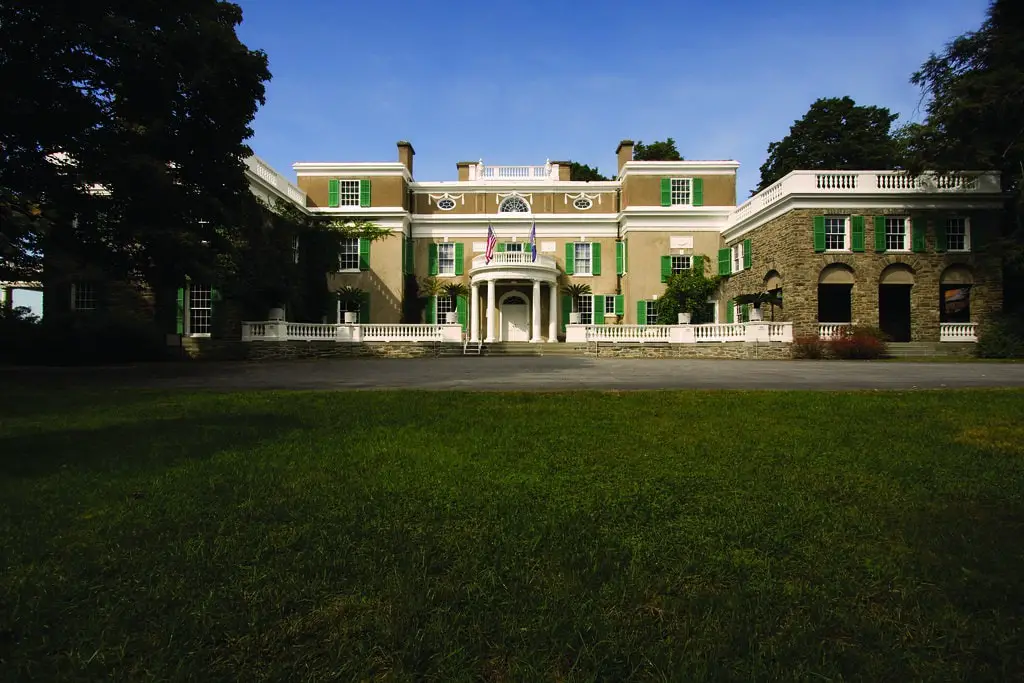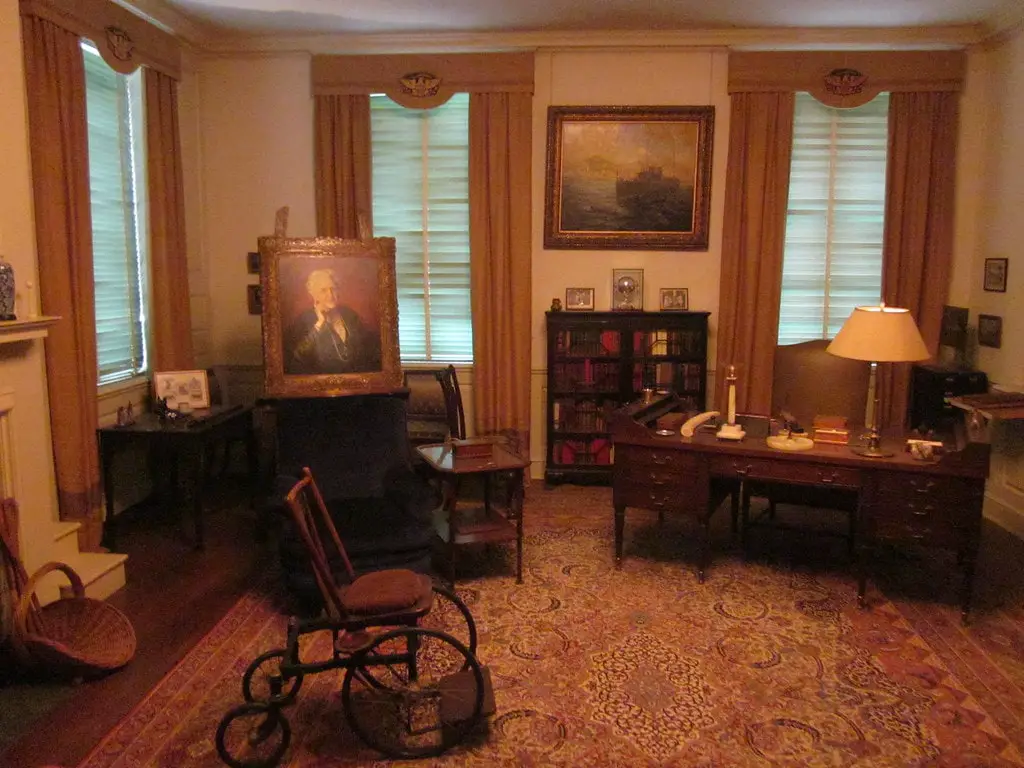The Land Before the Roosevelts
Nestled in Hyde Park, New York, the Springwood estate (now Home of Franklin D. Roosevelt National Historic Site) has a rich history that predates the Roosevelts. In 1697, the English Crown granted a 220-square-mile land area known as the "Great Nine Partners Patent" to nine businessmen.
This parcel of land stretched from the Hudson River to the Connecticut border. William Creed was one of the original owners of the "Water Lots," and the Springwood estate is situated on his portion.
The estate underwent several transformations over the years. The central part of what is now the Home of Franklin D. Roosevelt was originally a Federal-style farmhouse built around 1800. By 1845, Josiah Wheeler, a merchant from New York City, had purchased the estate. He remodeled it in the Italianate style, expanding it to 15 rooms and adding a three-story tower.
The architectural style of the estate was a sign of the times. Italianate style was the trend, and Wheeler incorporated it into the design. Front and rear piazzas were added, spanning the length of the home, giving it a grand appearance that would later befit a future president.
The land and its houses have seen many owners and styles, but the Roosevelts would give it lasting significance. The estate is a testament to the various layers of history that have shaped it, each contributing to its current status as a National Historic Site.
The Roosevelt Era Begins
In 1866, James Roosevelt Sr. acquired the Springwood estate for $40,000. At that time, the average earnings of a textile worker were less than a dollar a day, making this a significant investment. James was keenly interested in horse breeding, making the estate's stable and horse track indispensable features.
Franklin D. Roosevelt was born at the estate in 1882, in a second-floor tower bedroom. This room functioned as the main bedroom at the time. The bedroom that Franklin and later his sons used during their boyhood is also on the same floor. The estate was not just a home but the backdrop for significant moments in the Roosevelt family's life.
In 1905, Franklin married Eleanor Roosevelt, and the young couple moved into the estate with Franklin's mother, Sara. From then on, the Home of Franklin D. Roosevelt remained the center of his life through all career stages. It was more than just a residence; it was a cornerstone of his identity.
Through his death in 1900, James Roosevelt Sr. made many improvements to the property. He enlarged the servants' wing, added two rooms, and built a spacious carriage house nearby. These changes set the stage for the estate's future role in American history.
Architectural Evolution Under FDR
By 1915, Franklin and his mother Sara undertook a final significant enlargement and remodeling of the home. This accommodated his growing family and created an environment suitable for entertaining political associates. Franklin had ambitions, and the house needed to reflect that.
The design work was commissioned from Hoppin & Koen of New York City. The residence expanded significantly with the addition of two substantial fieldstone wings. The original clapboard facade gave way to a stucco exterior. At the same time, most of the porch was transformed into a fieldstone terrace, complemented by a petite portico with columns at the entrance.

The alterations gave the exterior of the Home of Franklin D. Roosevelt the look of a Colonial Revival mansion. While retaining much of the original layout, the interior was redesigned primarily to house Roosevelt's growing collections of books, paintings, stamps, and coins. The remodeling work was completed within a year, in 1916.
Franklin also changed the appearance of the surrounding land through extensive tree plantings. From 1911 until his passing in 1945, the estate planted over 400,000 trees, significantly altering its landscape. Large portions of the estate were even turned into an experimental forestry station in an agreement with the Forestry Department of Syracuse University.
Springwood as the "Summer White House"
Throughout his time in office, from March 4, 1933, to his passing April 12, 1945, Franklin frequented Springwood nearly 200 times. The estate served as a seasonal presidential residence, welcoming a host of both national and international dignitaries. It was more than just a retreat; it was a hub of political activity.
In June 1939, King George VI and Queen Elizabeth became the first sitting British monarchs to set foot on American soil. They were hosted at the Home of Franklin D. Roosevelt, marking a significant moment in international relations. Among the esteemed guests were British Prime Minister Winston Churchill and European nobility like Princess Juliana, Queen Wilhelmina, and Princess Beatrix from the Netherlands.

On the nights before three of the four presidential elections he contested, Roosevelt retreated to the estate with his political circle. As election results came in, signaling a win, he would step out onto the front terrace to give his victory speech, cementing the estate's status as a political epicenter.
Franklin visited Springwood in the final week of March 1945, just two weeks before his death. Franklin D. Roosevelt was laid to rest close to the Rose Garden's sundial on April 15, 1945. After passing in 1962, Eleanor Roosevelt was interred next to her husband. The estate remains where visitors can pay their respects to one of America's most influential presidents.
Home of Franklin D. Roosevelt Rooms
The Home of Franklin D. Roosevelt has various rooms, each with history and significance. The Entrance Hall welcomes visitors with its grand staircase and features a collection of family portraits. The Living Room, with its large fireplace, served as a gathering place for the family and guests alike.
The Library is perhaps the most personal room in the house. It contains Roosevelt's vast collection of books, naval prints, and ship models. The room also features a desk that Franklin used during his presidency. The Music Room, adjacent to the Library, contains a grand piano and was a favorite of Eleanor Roosevelt, who often hosted musical evenings there.

Sara Roosevelt had her own space, the "Snuggery," her private sitting room. It contains a collection of porcelain and family miniatures. The bedrooms of Franklin and Eleanor are also part of the tour, each reflecting their tastes and the era in which they lived.
The house has original furnishings, including family heirlooms and period antiques. Many of the pieces have been donated back to the house by Roosevelt family members and are displayed as they were during Franklin's lifetime. This gives visitors a sense of stepping back in time.
The Legacy Preserved
In 1943, Franklin D. Roosevelt gifted the estate to the American people, stipulating that his family would retain access to it following his demise. The National Park Service took over the management of the site in 1946. The Home of Franklin D. Roosevelt was designated a National Historic Site on January 15, 1944, and was listed on the National Register of Historic Places on October 15, 1966.
The Franklin D. Roosevelt Presidential Library and Museum was established on the estate in 1941. It was the first presidential library and remains one of the most visited. The library holds Roosevelt's presidential papers, his collections, and the papers of Eleanor Roosevelt, making it a treasure trove for historians and researchers.

Even amid the difficulties brought on by the COVID-19 pandemic, the site drew an impressive crowd of more than 108,000 visitors in 2020. The estate continues to be a place of pilgrimage for those interested in American history, the Roosevelts, and the New Deal era.
Today, the Home of Franklin D. Roosevelt is a living monument to a man who shaped American history. It's not just a museum or a collection of old buildings; it's a place where history comes alive. Visitors can walk the same halls that Roosevelt did, ponder the same views, and perhaps leave with a deeper understanding of the man and his era.
